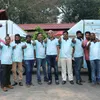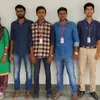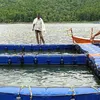Deep tech at sea: this startup helps fishermen in India to take IoT-enabled decisions
Started in 2016, Bengaluru-based InCEve Electronics sells sonars that can help the fishermen fish effectively, saving fuel cost, time, and improving the quality of the catch.
India, which has an ocean to its name, has a thriving fishing industry, and is one of the top 25 producer countries in the world. According to the National Fisheries Development Board, the industry employees 14 million people, with the total fish production during 2017-18 estimated to be 12.60 million metric tonnes, and contributing to around 6.3 percent of the global catch.
Needless to say, there is plenty of activity in the sector, but not much of technological intervention yet.
Central Marine Fisheries Research Institute had pointed out that climate change is affecting fisheries through changes in stock productivity and its distribution.
Moreover fishermen in India still use traditional techniques to catch fish. Most of them work on a trial-and-error basis, since they are not skilled enough to use modern techniques, resulting in a huge waste of time, effort, and money.
Another major challenge is predicting the direction and the size of fish schools - factors that are important while casting a net and pulling them in. The complex task requires roughly three hours and 40 men.
This is why, in 2016, Balaji K, Chitty Babu G, Sambathkumar S, and Dr Karthikeyan R started InCEve Electronics in Bengaluru.

(L-R) Sambathkumar, Balaji, Dr Karthikeyan and Chitty Babu
InCEve, an Internet of Things (IoT)-based sonar device, helps fishermen use the right technology to automate this process and capture the right information to catch fish schools.
It essentially assists fishermen to see where the fish are, how the fish school is moving, its size, and other parameters to optimise their time at sea. It gives an underwater and 360-degree vision of the waters as well. This not only saves fuel cost and time, but also improves the quality of the catch.
The device allows the fishermen to take a call on when to net and whether to net or not in the first place.
Identifying the problem
The founders together started Teclever Solutions, the parent company of InCEve Electronics, in 2006, where they were involved in providing deep technology solutions and understanding business ecosystems in the systems engineering market segment.
Chitti Babu says that fish stocks are usually either over exploited or under exploited. “This results in in a waste of time, effort, and money. Also, with the present trend of climate change, spanning patterns, availability of fish stock is not measured. The changing temperature, salinity, and weather are crucial along with the sea bed conditions for effective long term solutions.”
The team also realised that there is no usage of sonars - a system that uses sound propagation to navigate or detect objects like fish in water apart from simple fish finders - in the Indian market. The sonars in the market (especially searchlight sonars) have not been upgraded over the years and are quite expensive as well.
This is when the team joined hands with sonar industry expert Nathan Roundy and started looking closely at the problem.

The InCEve sonar device
“We found that the rest of the world goes fishing with at least two sonars on board, just in case one gives trouble. When it comes to India, though, sonar penetration is almost zero,” says Balaji.
The founding team understood the gaps in the Indian market and decided to change the scenario.
Implementing InCEve
“The complete InCEve product is very complex. It needs multidisciplinary engineering talent - RF engineers, hardware design, firmware engineers, mathematics, physics, mechanical engineering, cloud, and mobile technologies. The founding team has in-house experience of over 20 years and had a perfect fit, thus bringing in combined expertise,” Balaji says. At present, InCEve Electronics is a team of 12 people.

The device being installed in boats.
The data is monitored and collected by InCEve, after which it helps the fishermen fish effectively.
InCEve Electronics comes with instructions in vernacular languages ensuring everyone can follow them easily. At present, the company supplies its device to areas like Malpae, Goa, Honnavar, Cuddalore, and Nagapattinam.
How does it help fishermen?
“InCEve believes in sustainable fishing. The impact is almost immediate for fisherman who get RoI in months. InCEve collects data like sea bed conditions, temperature of surface seawater, acidity, and other parameters, and uses it to analyse fast-changing and unpredictable weather conditions. Even the spawning season can be predicted, ensuring the fish stock is not under or over utilised,” Balaji explains.

Monitoring the sea
Fisherman Shridhar G Naik from Honnavar, a port town in Karnataka, says, “It is a very useful tool and helps us to reduce fuel cost and most importantly, lets us know the direction in which the school of fish is moving.”
Chitti Babu adds that their product can increase the profitability of fisherman, and - at the same time - build complete data to enable sustainable fishing in the near term.
Sailing through the challenges
The team has invested around Rs 6 crore in the company to reach the production stage now. It dedicated its initial years in researching and developing the product.
However, sourcing the right material was tough. The company had to import the right transducer material, which took couple of iterations as it could not be sourced in India.
“Accessibility to test environment was a big challenge. We had to travel either to the east coast or the west with our production house in Bengaluru. As a self-funded initiative, we had to work within our limits, be it for R&D or for product testing on the coast. As a product with high level of entry barrier, we could afford a little extra time for R&D,” says the co-founder.
The company is currently in the pre-launch mode and has made and sold around 50 units so far.
“Without our product, the fishermen will catch everything. They will kill the fish even before it is spawned. Imagine if every fisherman were to do it. It will have a direct impact on marine ecology,” Balaji says.
InCEve’s long-term objective includes the promotion of sustainable fishing by measuring salinity, acidity, and sea bed conditions at every point of time.
(Edited by Evelyn Ratnakumar and Saheli Sen Gupta)










